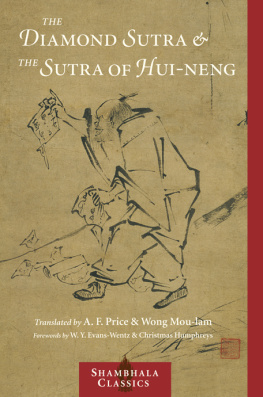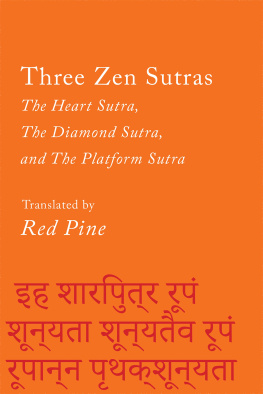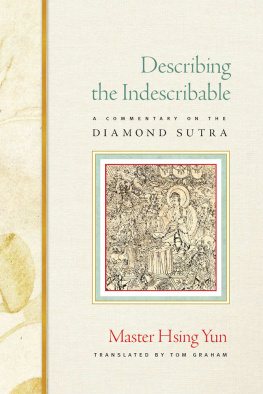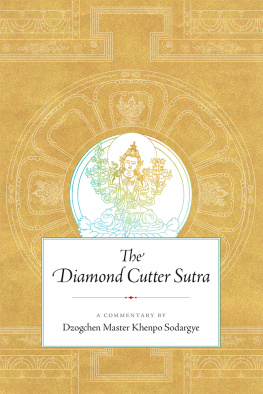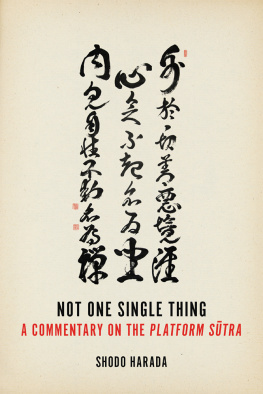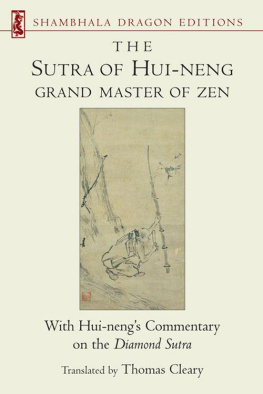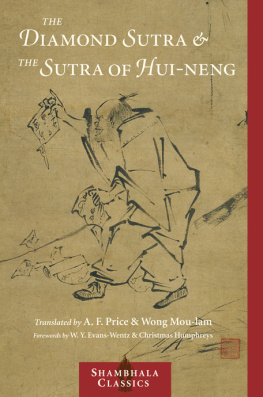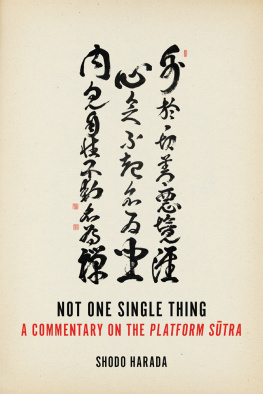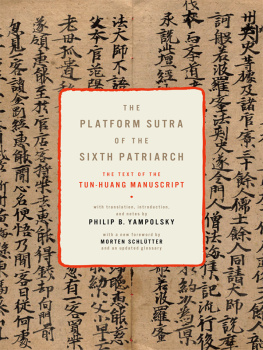ABOUT THE BOOK
The Diamond Sutra, composed in India in the fourth century CE, is one of the most treasured works of Buddhist literature and is the oldest existing printed book in the world. It is known as the Diamond Sutra because its teachings are said to be like diamonds that cut away all dualistic thought, releasing one from the attachment to objects and bringing one to the further shore of enlightenment. The format of this important sutra is presented as a conversation between the Buddha and one of his disciples. The Sutra of Hui-neng, also known as the Platform Sutra, contains the autobiography of a pivotal figure in Zen history and some of the most profound passages of Zen literature. Hui-neng (638713) was the sixth patriarch of Zen in China, but is often regarded as the true father of the Zen tradition. He was a poor, illiterate woodcutter who is said to have attained enlightenment upon hearing a recitation of the Diamond Sutra. Together, these two scriptures present the central teaching of the Zen Buddhist tradition and are essential reading for all students of Buddhism.
Sign up to learn more about our books and receive special offers from Shambhala Publications.

Or visit us online to sign up at shambhala.com/eshambhala.

Shambhala Publications, Inc.
Horticultural Hall
300 Massachusetts Avenue
Boston, Massachusetts 02115
www.shambhala.com
Cover art: The Sixth Patriarch Tearing Up a Sutra, by Liang Kai (active first half of the 13th century), hanging scroll, ink on paper, 73 x 31.7 cm. Courtesy of Mitsui Bunko Foundation, Tokyo.
All rights reserved. No part of this book may be reproduced in any form or by any means, electronic or mechanical, including photocopying, recording, or by any information storage and retrieval system, without permission in writing from the publisher.
The Library of Congress catalogues the previous edition of this book as follows:
The Diamond sutra and the Sutra of Hui Neng. Translated by A. F. Price and Wong Mou-lam. With forewords by W. Y. Evans-Wentz, J. Miller, and C. Humphreys.
The Sutra of Hui Neng is a translation of Liu tsu ta shih fa pao tan ching includes bibliographical references.
eISBN 978-0-8348-2609-0
ISBN 0-87773-005-9 (pbk., Dragon Edition)
ISBN 1-59030-137-4 (pbk., Shambhala Classics)
I. Hui-neng, 683713. Liu tsu ta shih fa pao tan ching. English. 1969. II. Price, A. E, tr. III. Wong, Mou-lam, tr. IV. Title.
294.385dc19
78-237407
MARC
Come, Blessed One, we pray Thee, roll the wheel of the dew-sweet Lawwhich is excellent in the beginning, excellent in the middle, and excellent in the end!
LOTUS STRA
It is great joy to realize that the path to freedom that all the buddhas have trodden is ever existent, ever unchanged, and ever open to those who are prepared to enter upon it.
Precepts of the Gurus
The Rendering, the History, and the Significance of the Text
In presenting to the West this rendering of the Jewel of Transcendental Wisdom, Mr. Price reveals himself to be one of that noble band of translators and transmitters who in our time have added fresh effulgence to the light born of the East.
From India, the guru of the world, and the land wherein they first took written form, in Sanskrit, the Prajpramit scriptures were carried into China, and from the Chinese version of one of their various epitomes issues this English version here before us, which is characterized by praiseworthy simplicity of phraseology and diction, clarity of exposition, and unusually valuable notes that serve as a quite necessary commentary.
In my own presentation of a still more epitomized version of the Transcendental Wisdom, contained in book 7 of Tibetan Yoga and Secret Doctrines, I have set forth a brief account of the history and esotericism of the Prajpramit scriptures, which form a part of the third division of the Tibetan canon of Northern Buddhism, corresponding to the Abhidharma of the Pali canon of Southern Buddhism. In the Tibetan block print editions, the Prajpramit scriptures ordinarily comprise twenty-one books, contained in one hundred volumes of approximately one thousand pages each. Of these voluminous texts there are numerous epitomes in various oriental languages, ranging from the original Sanskrit to Mongolian and Japanese. For Northern, or Mahayanist, Buddhists, the Prajpramit scriptures are the most precious and sacred of their canonical writings. Ngrjuna, the fourteenth of the Buddhist patriarchs, who flourished during the first half of the second century C.E., is credited with having been the first teacher publicly to teach the supreme doctrine of the voidness as therein set forth. According to Ngrjuna, the dynasty of buddhas, of whom the Buddha Shkyamuni is the representative in this epoch, first enunciated the doctrine of the voidness, apparently in a purely esoteric manner, to highly advanced disciples. As our own text states, in section 15, The Tathgata has declared this teaching for the benefit of initiates of the great way; he has declared it for the benefit of initiates of the supreme way.
The Transcendence of the Doctrine of the Voidness
Although the doctrine is now accessible to all pilgrims on the quest for truth, nevertheless, for many of them, as for the unenlightened multitude, it remains in essence esoteric. Until the Occident outgrows its adolescent assumption of intellectual and spiritual superiority over the wise men of the East, it will fail to understand, much less to profit by, the doctrine of the voidness. Wherever progress is measured in terms of technology and not in terms of right understanding, the perfecting of the machine rather than of man will be the guiding ideal.
All supreme teachings, like these herein set forth, are for the purpose of emancipating humankind from worldly and conditioned existence; and once people are thus emancipated, there will be no need for technological perfection. When the butterfly has escaped from the chrysalis state and has cast aside the cocoon prison house, its former state as an earth-bound crawling caterpillar becomes obsolete. The world, however perfected it may become by means of utilitarian science, however utopian it may be made by human effort, can never be more, at best, than a state of chrysalism, preparatory to the incomparably greater state of nirvna.
Like the fabled frog who imagined the water in his well to be unsurpassed in depth and vastness and knew not of the deep, vast ocean, world-fettered men comprehend only the small and know naught of the great; they fail to comprehend the far-reaching significance of St. Pauls pronouncement: The things that are seen are temporal; the things that are unseen are eternal.
The Yoga of the Doctrine
The reading of no part of the Prajpramit scriptures, whether in epitomized form, such as that before us, or in the full twenty-one-volume form, can be profitably undertaken without profound seriousness. If these scriptures be, as they purport to be, nothing less than a guide to the other shore, to transcendence over all conditionedness, to a state of which no predication comprehensible to man immersed in the human state is possible, it must follow that they cannot be fruitfully studied by purely intellectual means. The translator, too, has given necessary admonition of this. The student should approach the doctrine of the voidness with a mind freed from all previously acquired intellectualisms, particularly if these be occidentally shaped. When the intent of the guidance set forth in our text has been to some degree understood, it should be self-evident that only by application of the deepest meditation can the disciple hope to advance on the path leading to superhuman wisdom.
Next page
